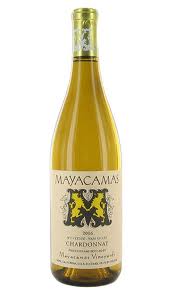|
|
 |

Mayacamas Vineyards, Mt. Veeder - Napa Valley, Chardonnay 2009 ($30): Not many of the wine lovers I know on the East Coast are talking much about California Chardonnay these days, probably because so many exciting alternatives exist among wines from other grape varieties and other places. But it’s a pity to ignore some of the very good Chardonnays  that California makes -- particularly the relatively small-production, estate wines that carry an AVA designation that’s smaller than just “California.” that California makes -- particularly the relatively small-production, estate wines that carry an AVA designation that’s smaller than just “California.”
This wine from the Mt. Veeder district of Napa Valley is just such a Chardonnay. It’s made entirely from Chardonnay grapes that grow on the Mayacamas property, its production is less than 1200 cases, and at $30 it offers great value.
A few years ago, I reviewed the Sauvignon Blanc wine of Mayacamas Vineyards and proclaimed it one of California’s very best Sauvignon Blancs. In fact, everything I’ve tasted from Mayacamas -- Cabernet Sauvignon, Merlot, and Chardonnay -- has been admirable. The historic property high on Mt. Veeder in the western edge of Napa Valley dates back to the 19th century. Since 1968, the Travers family has owned the estate, with vineyards at 1800 to 2400 feet altitude. For more than forty years, they have continued to produce distinctive, authentic wines from dry-farmed vines.
In a recent blind tasting of several Napa Valley Chardonnays, this 2009 Mayacamas was by far the finest wine. The evidence for its quality relative to the other wines included the fact that it is not sweet (sweetness in Chardonnay unfortunately extends beyond those inexpensive Chardonnays with merely a “California” designation), that it carries its alcohol well, and that its aromas and flavors include unusual mineral notes rather than just variations on the theme of fruitiness.
The aroma of this wine is not intense but it is complex, suggesting fresh banana, ripe pear, lemon, damp earth and top notes of mountain herbs. In your mouth, it’s full-bodied and richly-textured but not sweet; although the wine is not oaky in flavor, it has some gentle tannin of oak that contributes to the impression of dryness, as does the wine’s firm acidity. I would describe the wine’s taste as round and soft more than crisp, and yet when you hold the wine in your mouth, you can sense how the acidity works as a coil of energy on the mid-palate to hold the rich texture, fullness and softness together. The wine’s flavors are more pronounced than its aromas at this point; you might find apple, pear, figs, honey and a chord of minerality, a stony flavor.
After its cool fermentation, this wine aged for six months in large casks of American oak and then for a year in French oak barrels, only ten percent of which were new. It did not undergo malolactic fermentation or lees stirring. This winemaking regimen speaks of restraint, insuring that neither oak nor winemaking technique would subvert the complex, concentrated character of the grapes themselves.
This Chardonnay will age beautifully (a 2006 I recently tasted seemed a bit young) but it is also fine now. It can stand up to mildly spicy foods, grilled fish, dishes marked by the taste of fresh herbs, and mild cheeses.
92 Points
|
 |
|